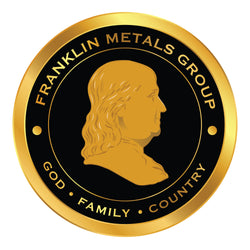
The reasons behind the escalation of precious metal prices
Today, gold and silver coins stand as enduring symbols of value amidst the decline of fiat currencies. Over the years, many clients at Franklin Metals Group have embraced our straightforward 'Swiss Diversification Strategy'.
Before delving into precious metal investments, it's crucial to grasp the current economic landscape and the underlying market dynamics steering the resurgence of tangible assets in a world saturated with debt and fiat substitutes.
The bullion and rare coin markets are influenced by a multitude of intricate factors. Since 2001, a convergence of internal and external dynamics has fueled a significant "secular" bull market across all forms of "real" money.
There are seven primary forces bolstering the ascent of gold and silver prices in the 21st century:
-
Depreciating U.S. Dollar: Gold, often termed the 'anti-dollar', serves as an ideal hedge against a weakening dollar. The dollar's decline by 40% since 2001, and a staggering 95% since the 1950s, remains largely misunderstood by the American populace. Investors, including central banks, are diversifying away from the dollar into foreign currencies, commodities, and gold, exacerbated by the U.S.'s daily borrowing of $2.5 billion, eroding confidence in its ability to manage trillions in debt.
-
Escalating Real-World Inflation: While official reports peg inflation at 2-3% annually, practical observation suggests a figure potentially double that. Considering monetary, asset, and price inflation, it's evident that inflation is outpacing official statistics. Throughout history, gold and rare U.S. coins have proven to be reliable inflation hedges.
-
Increasing Commodity Demand: A secular bull market in gold, silver, and commodities commenced in 2001, propelling oil prices from $25 to over $80 per barrel and quadrupling gold prices. Industry projections indicate this trend might persist until 2019-2024, with U.S. rare coins historically outperforming bullion during such periods.
-
Mounting Geopolitical Uncertainty: Since 9/11, global instability has heightened, making the world a volatile ideological, political, and economic battleground. Ongoing tensions in regions like Iran, Iraq, and Afghanistan underscore the potential for sudden spikes in gold and oil prices, driving demand for portable, universally accepted assets like gold and rare coins.
-
Surging Popularity of ETFs: Gold and silver ETFs, backed by allocated gold reserves, have gained traction as accessible investment vehicles. Despite concerns over transparency, ETFs have attracted substantial investment, creating buying opportunities in U.S. rare coins.
-
Expansion of Internet Trading: The internet has revolutionized the coin market, offering both advantages and risks. While it facilitates accessibility, buyers face challenges such as counterfeit or stolen coins. Auction websites present opportunities for sellers but carry risks for buyers unless coins are vetted by professionals.
-
Growing Interest in Coin Collecting: Initiatives like the U.S. Mint's Statehood Quarter program and the release of commemorative coins have spurred interest in coin collecting. The Mint's promotion of modern coins and precious metal IRA options has further bolstered the market, attracting new collectors and investors alike.
